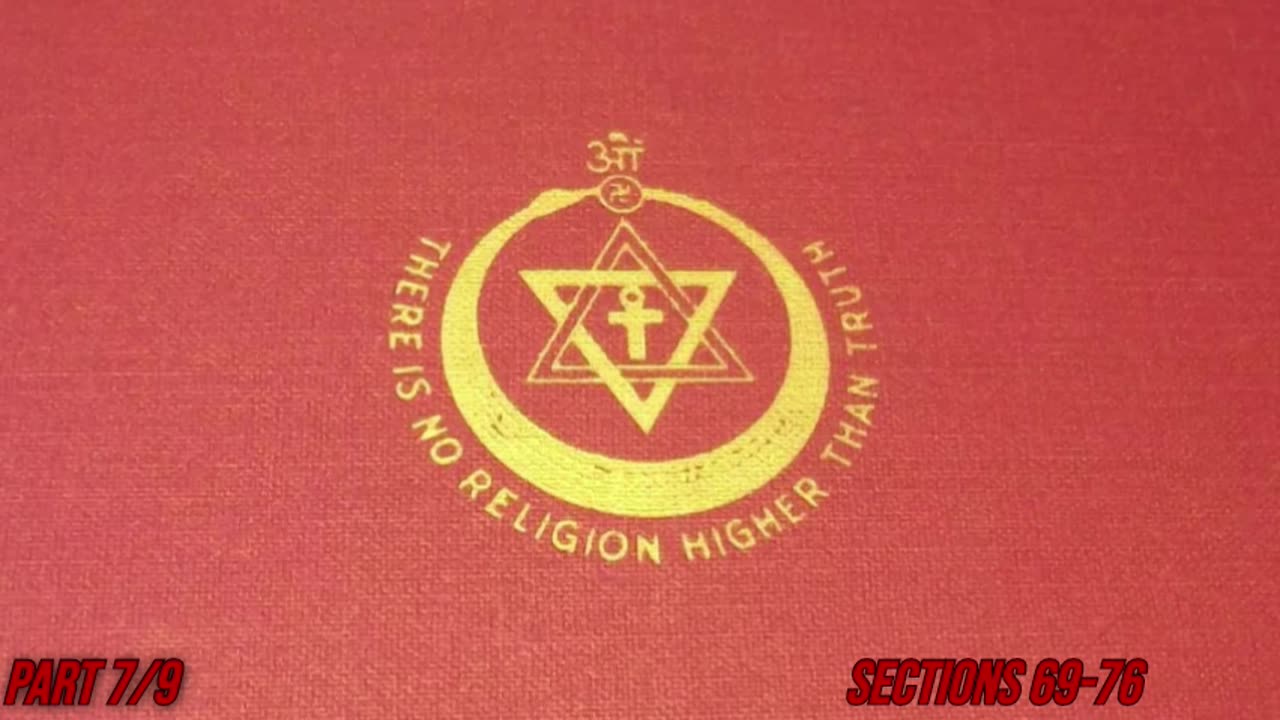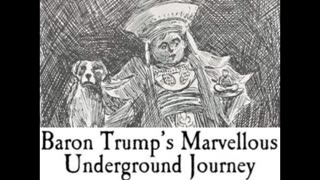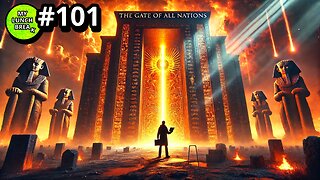Premium Only Content

The Secret Doctrine by Blavatsky Part 7/9 Sections 69-76
Part 7 (Sections 69-76) of "The Secret Doctrine" by Helena Petrovna Blavatsky continues to expand on the themes of esoteric knowledge, human evolution, and the cosmic mysteries that guide the development of spiritual consciousness. This part delves deeper into the interaction between the physical and spiritual realms, focusing on how occult principles influence world history, humanity's spiritual heritage, and the hidden forces that shape civilizations.
Overview of Part 7:
In this section, Blavatsky examines the symbolic interpretations of sacred texts from various spiritual traditions, such as the Vedas, Bible, Kabbalah, and Hermetic writings. She emphasizes that these texts contain veiled truths about the cosmic order and the spiritual journey of humanity. Blavatsky also explores the mystery schools, esoteric orders, and hidden teachings that have preserved this ancient wisdom, revealing how initiation and spiritual discipline play crucial roles in unlocking inner truths.
Key Concepts and Sections in Part 7:
1. Esoteric Interpretation of Sacred Texts:
Blavatsky continues her comparative analysis of religious and mystical scriptures, offering symbolic interpretations that reveal their hidden meanings. She focuses on how mythological stories and religious symbols are allegories for spiritual concepts and universal laws.
For example, she revisits the Genesis narrative and the symbolism of the Garden of Eden, presenting it as an allegory for the fall of spiritual consciousness into material existence. She draws parallels with Eastern creation myths, such as those found in the Upanishads and Zoroastrian cosmology, to argue that these stories encode similar esoteric teachings.
Blavatsky highlights how exoteric interpretations of these texts have obscured their deeper meanings, advocating for a return to their mystical roots.
2. The Role of Mystery Schools:
This section discusses the ancient mystery schools, such as those of Egypt, Greece, India, and Chaldea, which Blavatsky believes held the keys to esoteric knowledge. These schools were centers for spiritual initiation, where adepts and initiates were trained in occult sciences, astral knowledge, and cosmic laws.
Blavatsky suggests that these mystery schools preserved the ancient wisdom traditions that originated from Atlantis and the ancient East, passing on their teachings through symbolic rituals and sacred ceremonies.
She emphasizes the importance of initiation—a process of spiritual transformation that allows the seeker to access hidden realms and higher states of consciousness. These mystery teachings provided a pathway to self-realization and cosmic understanding for those deemed worthy.
3. The Nature of Occult Brotherhoods and Secret Orders:
Blavatsky elaborates on the concept of occult brotherhoods that operate behind the scenes, preserving and disseminating esoteric knowledge. She mentions groups such as the Rosicrucians, Hermetic orders, and Theosophical Society, suggesting that they carry on the legacy of the mystery schools.
She presents the idea that these secret orders exist to guide humanity's spiritual evolution and to safeguard ancient wisdom from being lost or corrupted. Blavatsky claims that such brotherhoods hold the knowledge of astral realms, cosmic cycles, and spiritual hierarchies.
Blavatsky’s discussion of these orders ties into her broader goal of positioning Theosophy as a modern expression of these ancient esoteric traditions.
4. Cosmic Laws and Human Destiny:
Blavatsky explores the cosmic laws that influence humanity's progress and destiny, such as the Law of Cycles and Karma. She argues that human civilizations rise and fall according to these universal laws, which are governed by spiritual principles.
The Law of Cycles is described as a universal pattern that dictates the emergence and decline of spiritual epochs, influencing the development of religious movements and mystical traditions. She suggests that many of the major shifts in human history, such as the rise of Christianity, are influenced by cosmic rhythms.
The Law of Karma, which governs cause and effect, is emphasized as a spiritual reality that extends beyond individual lives to encompass entire civilizations and epochs. Blavatsky presents karma as a mechanism of balance, ensuring that spiritual lessons are learned over many lifetimes.
5. The Astral Light and Occult Forces:
A critical element in Part 7 is the discussion of the Astral Light, which Blavatsky describes as an etheric substance that permeates the cosmos and acts as a record of past actions, thoughts, and events. This astral plane is seen as a mirror of the physical world, where occult forces and spiritual energies operate.
Blavatsky explains that magicians, adepts, and clairvoyants can access the Astral Light to gain insight into hidden truths, past lives, and cosmic principles. The astral realm is described as a repository of knowledge that is accessible only through spiritual discipline and initiation.
She warns of the dangers of misusing the powers associated with the Astral Light, cautioning that only those who have purified their intentions and hearts should attempt to access it.
6. The Evolution of Consciousness and Spiritual Hierarchies:
Blavatsky emphasizes that human evolution is not only a physical process but also a spiritual ascent, guided by spiritual hierarchies such as devas, archangels, and planetary spirits. These beings serve as intermediaries between the material world and the divine realms, helping to guide the spiritual progress of humanity.
According to Blavatsky, humanity's purpose is to ascend through these spiritual planes, gradually awakening to higher levels of consciousness. This evolution is seen as a cosmic journey that mirrors the mythological narratives of descent and ascent, where souls descend into material form and then rise back to spiritual purity.
She links this concept to mystical teachings from ancient Egypt, Hermeticism, and Buddhism, suggesting that they all contain the blueprints for understanding the evolution of consciousness.
Purpose of Part 7:
This section aims to reconnect modern readers with the esoteric traditions that have guided spiritual seekers throughout history, offering a deeper understanding of the hidden laws that govern both the cosmos and human evolution.
Blavatsky emphasizes the importance of initiatory knowledge as a means of accessing universal truths, suggesting that spiritual enlightenment requires the ability to interpret ancient symbols and occult teachings.
Style and Presentation:
Blavatsky’s writing in this part remains dense and symbol-laden, presenting complex ideas about spiritual hierarchies and cosmic laws. Her comparative approach continues, using mythological allegories and cross-cultural analysis to reveal the unifying threads among diverse spiritual traditions.
The text is framed as a guide for spiritual seekers, offering a pathway to deeper self-understanding and a framework for understanding the mystical nature of the universe.
Significance of Part 7:
Part 7 is significant for its attempt to synthesize ancient mystical traditions into a cohesive esoteric philosophy, providing readers with a framework for understanding the spiritual journey and the hidden forces that shape human destiny.
It serves as a bridge between theosophical teachings and ancient mystery schools, positioning Theosophy as a modern expression of the timeless wisdom that has been passed down through occult orders.
ABOUT THE AUTHOR:
Helena Petrovna Blavatsky (1831-1891)
Helena Petrovna Blavatsky—often known simply as Madame Blavatsky or HPB—was a Russian occultist, mystic, and co-founder of the Theosophical Society, a movement that sought to reconcile spirituality with science and philosophy by drawing upon ancient esoteric traditions. Born on August 12, 1831, in Ekaterinoslav, then part of the Russian Empire (now Dnipro, Ukraine), she is widely considered one of the most influential figures in the modern esoteric and occult revival of the late 19th century. Her writings and teachings, particularly "Isis Unveiled" (1877) and "The Secret Doctrine" (1888), continue to shape New Age thought, Western esotericism, and spiritual movements to this day.
Early Life and Influences
Blavatsky was born into a noble Russian family, with her mother, Helena Andreyevna von Hahn, being a novelist and her father, Colonel Peter Hahn, serving in the Russian military. From a young age, she displayed an interest in the mystical and supernatural, with accounts of her life mentioning experiences with clairvoyance, telepathy, and astral travel. Her family's access to Western literature and philosophy exposed her to esoteric ideas early on, which she later developed into her own theosophical framework.
In her early adulthood, Blavatsky embarked on extensive travels that took her across Europe, the Middle East, India, and Tibet. During these journeys, she claimed to have studied with esoteric teachers and initiates, particularly in India and Tibet, who taught her the ancient wisdom traditions that would form the core of her later teachings.
Founding of the Theosophical Society
In 1875, Blavatsky co-founded the Theosophical Society in New York City with Henry Steel Olcott and William Quan Judge. The society aimed to:
1. Promote the study of comparative religion, philosophy, and science.
2. Investigate unexplained laws of nature and the powers latent in humanity.
3. Promote universal brotherhood, transcending distinctions of race, creed, sex, caste, or color.
The Theosophical Society played a pivotal role in introducing Eastern philosophies, such as Hinduism and Buddhism, to the Western world, promoting the idea that all religions contain an underlying spiritual truth. Blavatsky served as the spiritual head of the movement, positioning herself as a messenger for the hidden masters or Mahatmas, whom she claimed were enlightened beings guiding the spiritual evolution of humanity.
Key Works and Esoteric Teachings
"Isis Unveiled" (1877): Blavatsky’s first major work sought to challenge materialism and scientific reductionism, arguing that ancient wisdom held the keys to understanding spiritual phenomena and the hidden aspects of nature. The book covered a wide range of subjects, from mythology to comparative religion, psychic phenomena, and occult sciences.
"The Secret Doctrine" (1888): This two-volume work is considered her magnum opus. It lays out a cosmological vision based on the Stanzas of Dzyan, which she claimed were ancient texts from Tibet. The first volume, "Cosmogenesis", focuses on the origin of the universe and cosmic evolution, while the second volume, "Anthropogenesis", explores the esoteric history of humanity through the seven root races. Blavatsky aimed to provide a synthesis of science, religion, and philosophy, drawing upon Eastern mysticism, Hermeticism, and Kabbalistic traditions.
Affiliations with Secret Societies
Blavatsky’s life and work were deeply intertwined with the esoteric traditions and secret societies that she studied and promoted. While there is some ambiguity surrounding her precise affiliations, her connections to various mystical and occult orders are well-documented:
1. Freemasonry:
Blavatsky claimed connections with Freemasonry, particularly through Co-Freemasonry and esoteric branches of the craft that included women, which was unusual for traditional Freemasonry. She was associated with Rite of Adoption lodges, a branch of Continental Masonry that allowed female members.
Her writings often reflect a Masonic worldview, utilizing symbolism and concepts familiar to Masonic teachings, such as the spiritual significance of geometric shapes and initiatory practices.
2. Rosicrucianism:
Blavatsky’s teachings frequently align with Rosicrucian ideals, emphasizing the existence of a hidden knowledge that dates back to ancient Egypt, Hermeticism, and alchemical traditions. She often spoke of the Rosicrucians as being among the guardians of ancient wisdom.
While no direct records confirm her initiation into a formal Rosicrucian order, Blavatsky’s writings suggest a deep sympathy for Rosicrucian principles, particularly in her emphasis on spiritual alchemy and the transmutation of the soul.
3. Hermetic Brotherhood of Luxor:
Blavatsky’s early writings and teachings have connections to the Hermetic Brotherhood of Luxor, a 19th-century occult order that combined Egyptian mysteries with Western esotericism. Some sources suggest that she had correspondences with members of this brotherhood, sharing a common interest in ancient Egyptian mysticism.
The Hermetic principles she discusses in her writings, such as the Law of Correspondence ("As above, so below"), reflect the influence of Hermetic thought on her theosophical worldview.
4. Kabbalistic Traditions:
Blavatsky’s work is heavily influenced by Jewish Kabbalah, which she viewed as a repository of esoteric wisdom with roots in ancient Chaldean and Egyptian mysticism. She believed that Kabbalistic teachings were closely related to the mysteries of the East, drawing parallels between Kabbalistic concepts and Vedic philosophy.
Although not formally initiated into any Kabbalistic society, Blavatsky incorporated Kabbalistic symbols, such as the Sephiroth and the Tree of Life, into her interpretation of the cosmos and spiritual evolution.
Controversies and Criticisms
Blavatsky’s life and work were marked by significant controversy. She faced criticism and skepticism from the scientific community of her time, as well as from Christian missionaries who opposed her promotion of Eastern religions in the West. Her claims of communication with the Mahatmas were challenged by skeptics, most notably during the Hodgson Report published by the Society for Psychical Research in 1885, which accused her of being a charlatan. However, many of her followers continued to believe in her spiritual authority and the validity of her occult experiences.
Legacy and Impact
Blavatsky’s influence extends far beyond her lifetime, shaping the New Age movement, Western occult traditions, and esoteric schools of thought. Her emphasis on the unity of all religions, the divine nature of the cosmos, and the importance of spiritual evolution has had a profound impact on mystical traditions and philosophical inquiries into the nature of reality. The Theosophical Society she co-founded continues to have branches around the world, promoting the study of esoteric philosophy and spiritual science.
Helena Petrovna Blavatsky remains a polarizing figure—revered by many as a spiritual visionary and pioneer of esoteric thought, while criticized by others as a controversial mystic with unorthodox ideas. Regardless of perspective, her role in reshaping the Western spiritual landscape and bridging Eastern and Western philosophies is undeniable, making her a central figure in the history of modern esotericism.
-
 6:23:02
6:23:02
Deus Meum Que Jus
15 days agoBaron Trump’s Marvellous Underground Journey (1893)
418 -
 1:33:06
1:33:06
Slightly Offensive
6 hours ago $2.61 earnedAre You Ready for What's Coming Next? | Just Chatting Chill Stream
42.7K29 -
 32:10
32:10
MYLUNCHBREAK CHANNEL PAGE
1 day agoThe Gate of All Nations
110K46 -
 13:07
13:07
Sideserf Cake Studio
10 hours ago $1.04 earnedIS THIS THE MOST REALISTIC SUSHI CAKE EVER MADE?
37.6K3 -
 21:08
21:08
Clownfish TV
1 day agoElon Musk Tells WotC to BURN IN HELL for Erasing Gary Gygax from DnD!
29.4K13 -
 48:22
48:22
PMG
6 hours ago $1.03 earned"IRS Whistleblowers Speak Out on Biden Family with Mel K In-Studio"
24.3K14 -
 2:59
2:59
BIG NEM
8 hours agoLost in the Wrong Hood: Who Do I Check In With?
19.5K2 -
 1:29:32
1:29:32
I_Came_With_Fire_Podcast
18 hours ago"UFOs, Nukes, & Secrecy: Bob Salas on the 1967 Malmstrom Incident, UAPs, & Disclosure"
133K28 -
 1:57:05
1:57:05
The Quartering
11 hours agoElon Musk To BUY MSNBC & Give Joe Rogan A Spot, MrBeast Responds Finally To Allegations & Much More
125K104 -
 3:01:18
3:01:18
EXPBLESS
13 hours agoFirst Time Playing Extraction Shooters | *LIVE* Arena BreakOut | #RumbleTakeOver
100K9